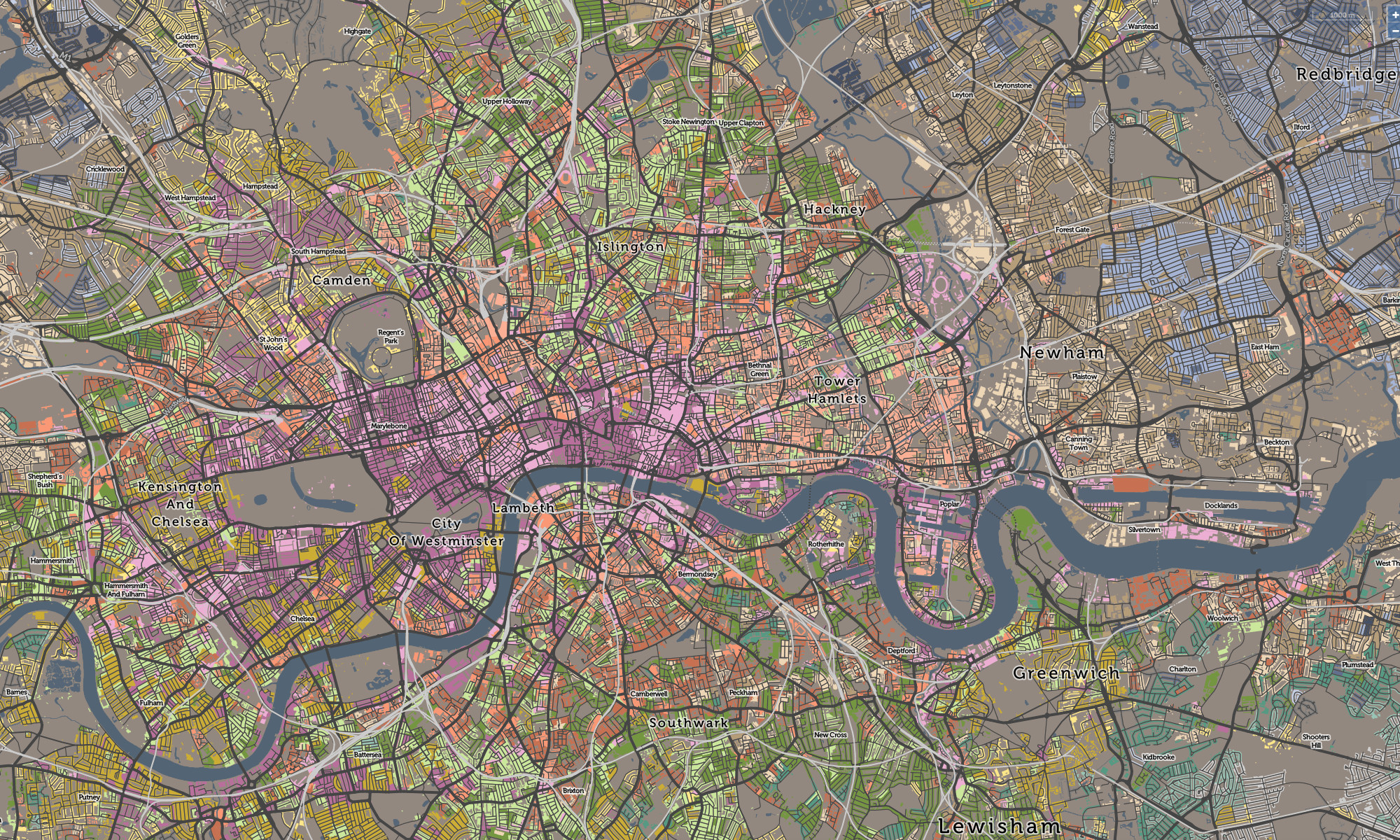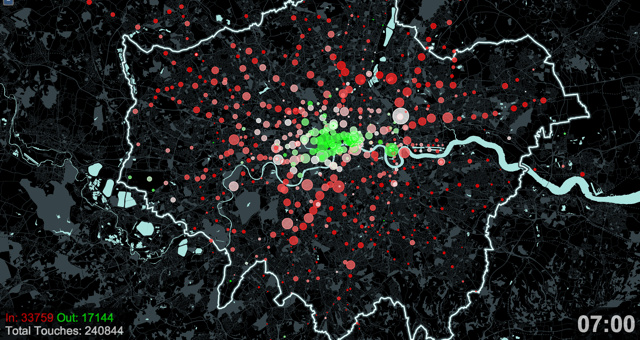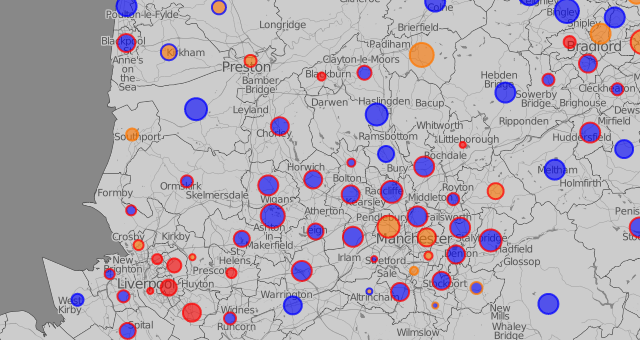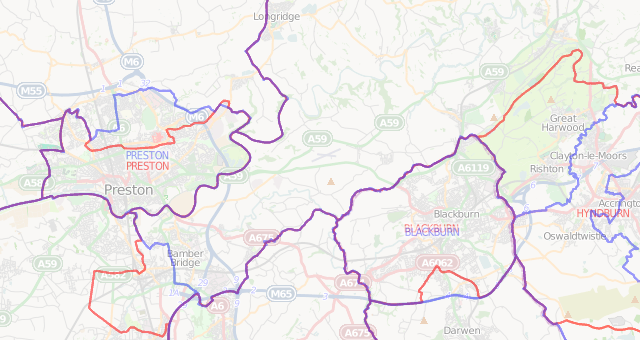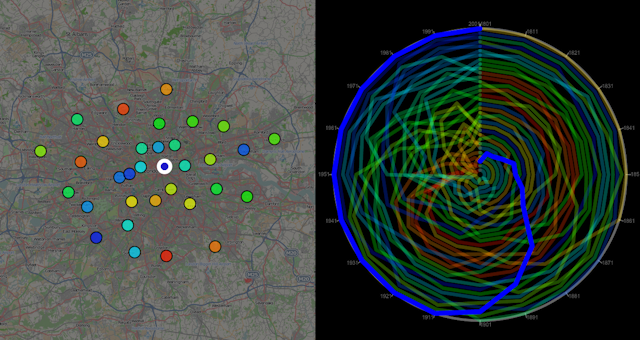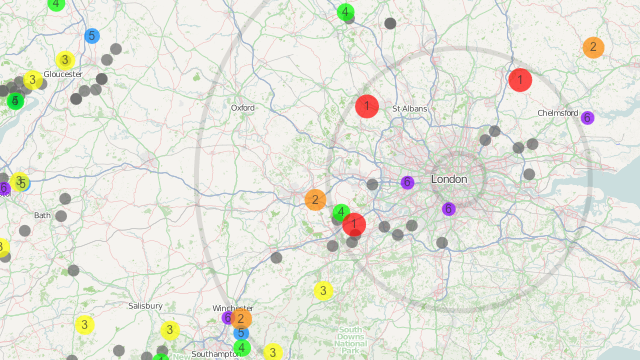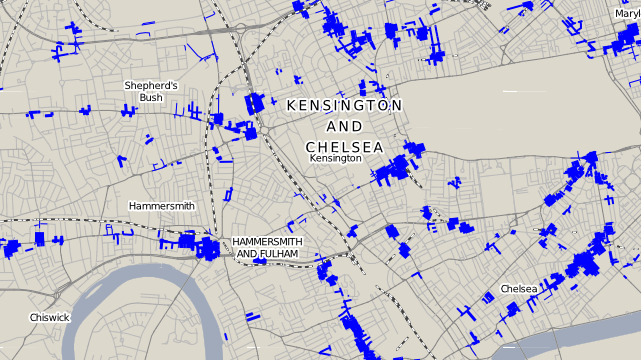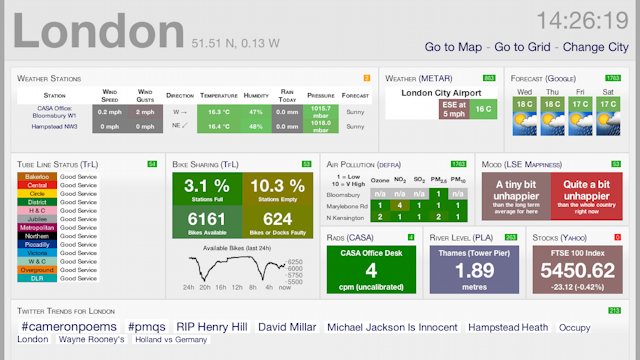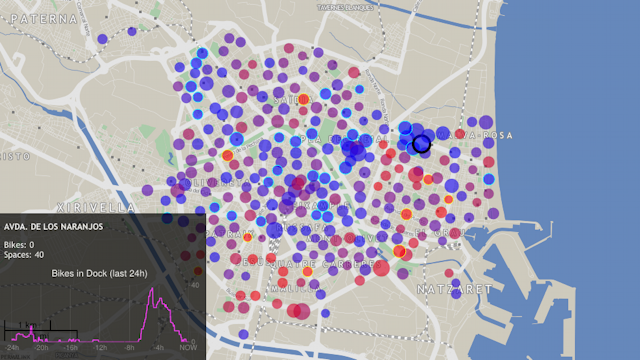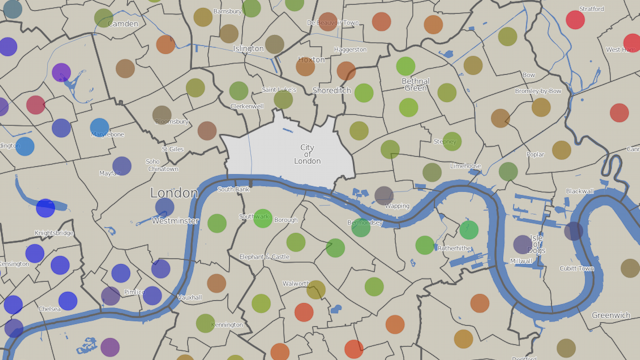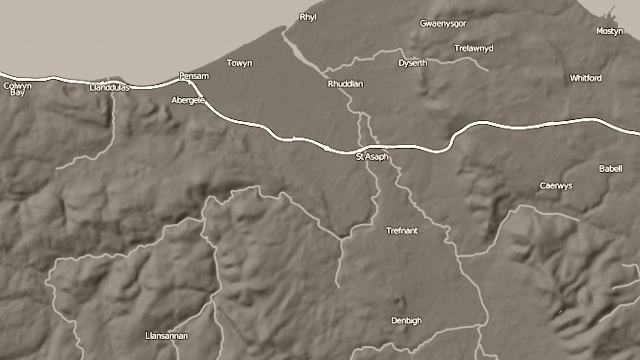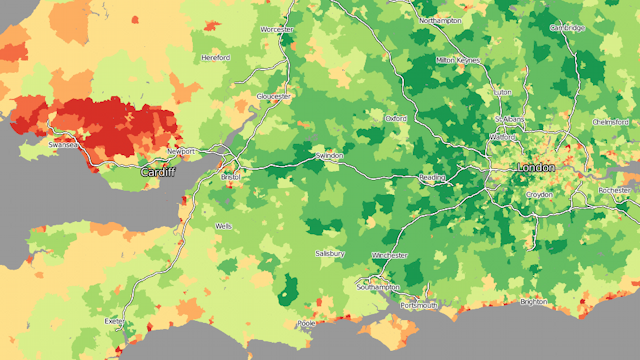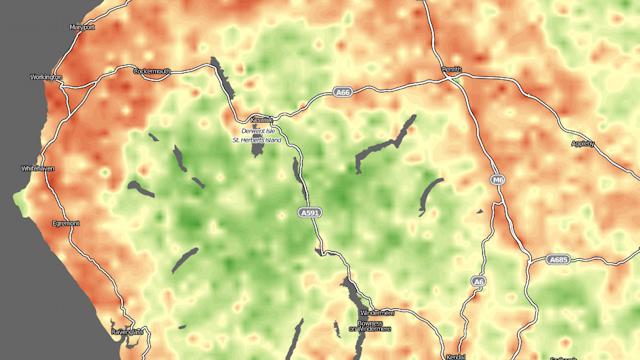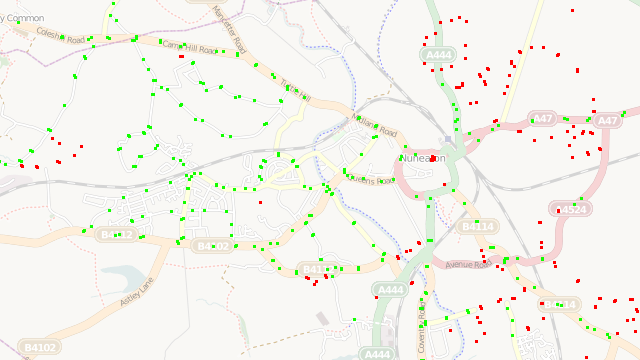TubeHeartbeat visualises the ebb and flow of commuters on the London Underground, using the HERE Maps developer platform. Click stations and line segments for detailed graphing.
Scottish Index of Multiple Deprivation
The SIMD Data Tool allows the easy and visual selection of data from the Scottish of Index of Multiple Deprivation.
CDRC Maps
CDRC Maps visualises a number of open datasets created or enhanced by CDRC Data, part of Consumer Data Research Centre.
DataShine
DataShine is a selection of website mapping socioeconomic data for the UK in a variety of different ways.
You can find out more about DataShine on the dedicated blog, which includes a listing of the DataShine websites.
Oyster Card Touches for a Weekday
This still is from an animation produced for an exhibition Sense and the City, which was at the London Transport Museum during 2011-12. The animation shows Oyster card “touch ins” and “touch outs” as people enter and leave the network of tubes and (some) trains, using the ubiquitous smartcard. Reds show a net influx into the system, while greens show a net flow outwards.
The London Periodic Table
An alternative view of CityDashboard data for London, using its API. Styled with coloured, glowing squares, with deliberately vague captions to encourage the viewer to think about what they mean. It can be viewed at http://casa.oobrien.com/periodictable/
UK General Election – Swing Map
This can be viewed at http://vis.oobrien.com/election/. It was my earliest “coloured circles in centroids” map and led to a London Council Elections map as well as the Bike Share Map. It primarily shows the predominant “swings” of the votes between parties, as compared with the previous general election.
It was originally published shortly after the election in 2010, but has been recently (2013) updated to utilise the latest version of OpenLayers, allowing it to be viewed effectively on mobile devices. The styling has also been slightly updated, with the user interface elements changed from solid dark blue blocks to translucent rounded black rectangles. It was further updated in 2015, to include the results from the General Election that year, as well as rebrand it as part of the DataShine portfolio of websites.
Boundary Changes
Showing the spatial impact of the proposed Boundary Commission revised constituency boundary changes (released in late 2016, for possible implementation in 2018) for the UK home nations (England, Scotland, Wales and Northern Ireland), by means of a slider fading between the current (red) and proposed (blue) outlines.
The website uses browser geolocation to default to your local area, and an OpenStreetMap background map. It is simple (200 lines of HTML/Javascript + Stylefiles for the Mapnik-based boundary map images), written in HTML5, and mobile-friendly. The original version (showing the 2013 proposals) was assembled in less than a couple of hours following publication of the data by the Boundary Commission for England. The latest version incorporates the proposals from the commissions of all four of the home nations, together in a seamless map. Zoom in to see the current/proposed names. The 2013 version also remains available for historical interest.
Rank Clocks on the Web
Using OpenLayers to show rank clocks as an interactive website.
Orienteering Fixtures Map
A daily updating map of forthcoming orienteering events in Great Britain.
Streets of Crime
Thickening the streets of west London proportionally based on the linear density of shoplifting crimes recorded along them.
(Work in progress.)
CityDashboard
CityDashboard shows real-time, rapidly updating data about a city – combining public transport information, weather and first-hand observations with social media (Twitter) trends and messages. CityDashboard is currently available for eight cities around the UK.
Bike Share Map
A visualisation of docking station states for around 50 cities with bicycle-sharing systems (similar to London’s Barclays Cycle Hire) across the world. Each circle, representing a docking station, moves from blue to red as the docking station fills up with bikes. The area of the circle represents the total size of the docking station. AJAX is used to load in the latest information every few minutes. The visualisation allows overall usage patterns to be seen during the day – the patterns being different for each city. An animation mode replays the last 48 hours, allowing commuter flows and other distinctive characteristics to be spotted. Various different colour schemes are available.
The background map is a custom render of OpenStreetMap data. It is designed to show relevant contextual information without distracting from the featured data.
Bike Share Map has been retweeted over 5000 times and derivatives of it have featured in magazines and newspapers including National Geographic Magazine (US June 2012 edition).
The map can be viewed at http://bikes.oobrien.com/. The above map is showing the bicycle-sharing system in Valencia, Spain.
London Council Elections
An interactive map showing the “colour” of each London ward, based on the results of the London Council Elections in May 2010. Each vote is considered to be red for Labour, blue for the Conservatives, and green for all other parties – the average “colour” can then be calculated and is displayed as a dot in the centre of each ward. The background is produced in Mapnik, with the circle symbology displayed using OpenLayers.
The visualisation can be viewed at http://casa.oobrien.com/misc/london/
Acknowledgements: Electoral data from the London Data Store. Ward and borough boundaries from Ordnance Survey Boundary-Line, part of the OS Open Data release. Contains Ordnance Survey data © Crown copyright and database right 2010. Background contextual data from OpenStreetMap, CC-By-SA OpenStreetMap and contributors.
Shaded Relief Maps
Using the SRTM (Shuttle Radiographic Topological Mission) data from NASA, and roads and placenames from OpenStreetMap, it is a relatively straightforward process to create a shaded relief map. The map is produced using the GDAL raster manipulation tools, with the labels and roads produced in Mapnik.
The sample here is of a region in north Wales.
Acknowledgements: Relief data from NASA’s SRTM. Contextual data from OpenStreetMap, CC-By-SA OpenStreetMap and contributors.
Health of the Nation
This choropleth map shows the results of the 2001 census question on health – in the greener areas, a greater proportion of the population in each statistical area consider themselves to be of good health, with redder areas indicating smaller proportions. The difference between the rural areas west of London, and north of Cardiff, are striking. A similar disparity can be seen when comparing east and west London.
Medium: Web. Acknowledgements: Census data is from the 2001 Census Area Statistics tables. Crown copyright 2003. Crown copyright material is reproduced with the permission of the Controller of HMSO. Statistical area boundaries from UKBORDERS, an EDINA-supplied service. Contains Ordnance Survey data © Crown copyright and database right 2010. Contextual data from OpenStreetMap, CC-By-SA OpenStreetMap and contributors.
London Underground Station Use
Visualisation showing the changes in use of the tube stations in London. The example here is showing the changes in total exits and entries (by foot) to the tube stations between 2008 and 2009. Blue circles show increases in numbers and red circles show decreases. The area of the circle is proportional to the changes in numbers. The largest red circle is for Blackfriars station which was closed throughout 2009. The surrounding stations show increased usage, compensating for this closure.
The visualisation can be viewed at http://oobrien.com/vis/tube/
Acknowledgements: Data from the Transport for London website. Background contextual and tube line data from OpenStreetMap, CC-By-SA OpenStreetMap and contributors.
A Map of Scenicness
This map was created from the results of voting by visitors to the ScenicOrNot, who voted on a representative photo in each square kilometre of the UK, supplied by the Geograph project. A GIS was used to create a surface showing the results graphically. The more green an area, the more scenic it was judged to be. Redder areas scored lower.
The extract here shows the central Lake District, which scored very highly. The scores drop along the corridor created by the M6 motorway.
Acknowledgements: Voting results data from from MySociety ScenicOrNot. Contextual data from OpenStreetMap, CC-By-SA OpenStreetMap and contributors.
Current status: Offline.
Finding the Roads from the Buses
This map is a visual representation of some simple spatial analysis. Shows bus stops on OpenStreetMap, imported in bulk from the NaPTAN (National Public Transport Access Nodes) dataset, overlaid on the standard OpenStreetMap render showing roads. Bus stops which are further than 40 metres from the nearest road are coloured red, to highlight places where a road is likely to be missing and should be targeted by the community when aiming to “complete” the map. The nearness calculation is performed using a spatial SQL query on the underlying PostGIS-based database.
Acknowledgements: Data from OpenStreetMap, CC-By-SA OpenStreetMap and contributors. Includes data from NaPTAN (National Public Transport Access Nodes) which is Crown Copyright and also released under CC-By-SA licence.
Current status: Offline. Following the OS OpenData release, and other improvements to OpenStreetMap data sources, the utility of this tool was largely superceded.
